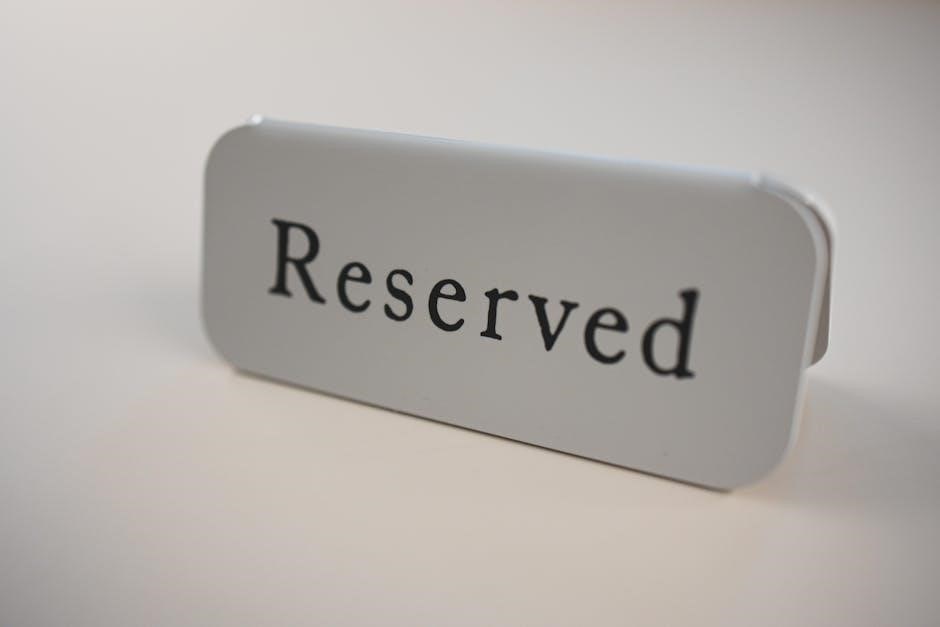A two weeks notice letter is a formal document informing an employer of an employee’s intention to leave their position, typically two weeks prior to departure. It ensures a professional exit and maintains positive relationships, often including a template for clarity and structure, making the resignation process straightforward and respectful for both parties.
1.1 Purpose and Importance of a Two Weeks Notice Letter
A two weeks notice letter serves as a professional document to formally announce an employee’s resignation, providing clarity and respect to the employer. Its purpose is to maintain trust and ensure a smooth transition, allowing the employer time to prepare for the employee’s departure. It demonstrates responsibility and courtesy, fostering a positive relationship even after leaving the job.
1.2 Brief Overview of the Two Weeks Notice Period
The two weeks notice period is a standard practice where an employee provides their employer with a formal resignation letter two weeks before their last working day. This period allows the employer time to find a replacement and ensures a smooth transition of responsibilities, maintaining professional courtesy and respect in the workplace.
Key Components of a Two Weeks Notice Letter
A two weeks notice letter should include your position, company name, last working day, and a thank you note for the opportunity, ensuring clarity and professionalism.
2.1 Essential Elements to Include
Your name, position, company name, date, and last day of work are crucial. Express gratitude for the opportunity and offer assistance for a smooth transition, maintaining professionalism throughout. Include your signature and contact information for formal closure and clarity.
2.2 Standard Format and Structure
A two weeks notice letter typically includes your contact information, date, employer’s name, subject line, salutation, statement of resignation, last day of work, offer to assist with the transition, thank you note, and your signature. This structured format ensures clarity, professionalism, and respect for the process, making it easy for employers to understand your intentions and plan accordingly.

How to Write a Two Weeks Notice Letter
Start with your contact info, date, and employer’s details. Clearly state your resignation, specify the last work day, and offer assistance for a smooth transition. Remain polite and professional throughout, ensuring clarity and respect for your employer.
3.1 Step-by-Step Guide to Crafting the Letter
Begin with your contact information, followed by the date and employer’s details. Clearly state your resignation, specify your last workday, and express gratitude. Offer assistance for the transition, maintain a polite tone, and close with your signature. Ensure the letter is concise, professional, and respectful, adhering to traditional letter-writing standards for clarity and effectiveness.
3.2 Tips for Writing a Professional and Polite Resignation Letter
Keep your tone positive and respectful, avoiding negative comments. Clearly state your resignation and last workday, and express gratitude for the opportunity. Offer to assist with the transition, such as training a replacement. Use formal language, maintain professionalism, and ensure proper formatting. Customize the letter to fit your situation, and proofread for errors before submission to ensure clarity and politeness.
Two Weeks Notice Letter Templates and Samples
Downloadable PDF templates and samples provide structured formats for resignation letters, ensuring clarity and professionalism. They include placeholders for personal details, making customization straightforward and efficient for employees.
4.1 Downloadable PDF Templates
Downloadable PDF templates offer a convenient and professional way to draft a two weeks notice letter. These templates are available for free or purchase, providing a structured format with placeholders for personal details, job titles, and dates. They ensure clarity and correctness, saving time and effort. Many platforms provide customizable options, allowing users to tailor the content to their specific resignation needs while maintaining a formal tone and structure.
4.2 Sample Letters for Different Scenarios
Sample letters for various scenarios provide tailored templates for resignations, ensuring the notice aligns with individual circumstances. Whether for immediate departure, remote positions, or career transitions, these examples offer customizable solutions. They cater to different job roles and situations, providing clear structure and language guidance. Users can adapt these samples to fit their specific needs, ensuring professionalism and clarity in their resignation process.

Best Practices for Submitting a Two Weeks Notice
Submit your notice during a private meeting, ensuring professionalism and respect. Provide the letter in person or via email, maintaining a polite tone. Offer to assist with the transition, fostering goodwill with your employer and colleagues, and ensuring a smooth handover of responsibilities.
5.1 Timing and Delivery of the Letter
The two weeks notice letter should be delivered in a timely manner, ideally during a private meeting with your supervisor. Ensure the letter is submitted two weeks before your last working day, allowing sufficient time for the employer to plan the transition. Hand-delivering or emailing the letter during work hours demonstrates professionalism and respect for the process. Proper timing helps maintain a positive relationship and ensures a smooth exit strategy. Always keep the tone polite and professional, as this reflects well on your character and commitment to your role. The letter should clearly state your last day of work and express gratitude for the opportunities provided during your tenure with the company.
5.2 Maintaining a Positive Relationship with Your Employer
Maintaining a positive relationship with your employer is crucial during resignation. Express gratitude for the opportunities provided and acknowledge the experience gained. Offer assistance with the transition, such as training a replacement or handing over responsibilities. Keep communication open and respectful, ensuring a professional tone throughout the process. A positive exit fosters goodwill and preserves professional connections for future endeavors.

Common Mistakes to Avoid in a Resignation Letter
Common mistakes include being too casual, omitting key dates, and forgetting to proofread. Always maintain professionalism and clarity to ensure a respectful exit.
6.1 What Not to Include in Your Notice Letter
Avoid including emotional language, complaints about the company, or negative remarks about colleagues. Do not mention future job details excessively or include reasons for leaving unless necessary. Keep the tone professional and avoid any confrontational or ungrateful statements. Ensure the letter remains concise, respectful, and focused on your departure date and transition plans.
6.2 Avoiding Negative or Emotional Language
Maintaining professionalism is crucial in a resignation letter. Avoid expressing frustration, anger, or dissatisfaction, as it can harm your relationship with the employer. Refrain from making negative comments about colleagues, management, or company policies. Emotional language can create a lasting negative impression, so focus on gratitude for the opportunity and keep the tone respectful and courteous throughout the letter.
Legal Considerations for Resignation Notices
Understand your employment contract to ensure compliance with resignation terms. Adhere to labor laws, including notice periods and confidentiality agreements, to avoid legal complications during your exit.
7.1 Understanding Your Employment Contract
Review your employment contract to identify the required notice period, which may exceed two weeks. Ensure compliance with termination clauses to avoid legal disputes. Adhere to any specified procedures for submitting resignation, such as formal letters or emails. Understanding your contractual obligations ensures a smooth exit and maintains professional integrity, protecting both you and your employer from potential misunderstandings or legal action.
7.2 Compliance with Labor Laws and Regulations
Labor laws require employers and employees to adhere to specific resignation guidelines, ensuring fair termination processes. The two weeks notice period aligns with standard legal requirements, providing a framework for smooth transitions. Compliance protects both parties from legal disputes, ensuring the resignation process is conducted professionally and ethically. Always verify local labor laws to guarantee your notice letter meets all necessary legal standards and expectations.

How to Customize a Two Weeks Notice Letter Template
Personalize the template by adding your name, job role, company details, and last working day. Customize the tone to reflect your professional relationship and circumstances, ensuring clarity and respect.
8.1 Personalizing the Template for Your Situation
Customize the template by inserting your name, job title, company name, and last working day. Tailor the tone to match your professional relationship and circumstances. Include specific details about your resignation, such as gratitude for opportunities or offers to assist with the transition. Ensure the language remains professional and respectful, reflecting your individual situation and maintaining a positive tone throughout the letter.
8.2 Adding Specific Details About Your Resignation
Incorporate specific details such as your job title, last working day, and any offers to assist with the transition. Clearly state your resignation date and express gratitude for the opportunities provided. Mentioning your position, department, and any key responsibilities ensures clarity. Tailor the letter to reflect your unique situation, maintaining a professional and respectful tone throughout, while providing all necessary information for a smooth departure.

Professional Tone and Language in Resignation Letters
A professional tone in a resignation letter is crucial for maintaining respect and clarity. Expressing gratitude and avoiding negative language ensures a respectful and clear communication of your intent.
9.1 Importance of Maintaining Professionalism
Maintaining professionalism in a resignation letter is essential for preserving your reputation and ensuring a positive relationship with your employer. A well-crafted, polite tone fosters mutual respect, ensuring a smooth transition and leaving a lasting impression of integrity and reliability, which is crucial for future career opportunities and references. Professionalism demonstrates maturity and consideration.
9.2 Examples of Appropriate Language
Use clear and respectful language, such as expressing gratitude for the opportunity to work with the company. Phrases like “I appreciate the experience” or “I am committed to a smooth transition” convey professionalism. Avoid negative remarks and maintain a courteous tone throughout the letter, ensuring it reflects your appreciation and commitment to your responsibilities until your departure.

Two Weeks Notice Letter Examples
Sample letters provide clear templates for various roles, offering structured formats that employees can customize to suit their resignation needs, ensuring clarity and professionalism in their notice.
10.1 Sample Letters for Different Job Roles
Sample letters are tailored for various professions, such as managers, engineers, or customer service reps, offering customizable templates. These examples include placeholders for company name, position, and last day, ensuring clarity and professionalism. They provide a structured format for employees to express gratitude and confirm their departure details, making the resignation process seamless and respectful across industries.
10.2 Examples of Formal and Informal Resignation Letters
Formal resignation letters follow a structured format, emphasizing professionalism and clarity, while informal ones are more conversational. Examples include formal templates with company letterhead and salutations, and informal versions using casual language. Both types should include essential details like the last working day and gratitude, ensuring the tone aligns with the workplace culture and relationship with the employer.

When to Use a Two Weeks Notice Letter
A two weeks notice letter is appropriate when resigning from a position, ensuring a professional transition and maintaining positive relationships with employers and colleagues.
11.1 Appropriate Situations for Submitting a Notice
A two weeks notice letter is suitable when resigning from a job, transitioning to a new role, or leaving for personal reasons. It is ideal for maintaining professionalism and ensuring a smooth transition, especially in formal work environments where proper etiquette is expected.
11.2 When Two Weeks Notice May Not Be Required
A two weeks notice may not be required in cases of mutual agreement with the employer, immediate job offers, or urgent personal circumstances. It is also waived if transitioning within the same company or in cases of contract termination. Always review employment contracts to understand specific requirements and exceptions.
The Difference Between Email and Formal Letter Resignation
Email resignations are faster and informal, while formal letters are traditional and professional, often preferred for official records and maintaining proper protocol. Both ensure clarity and respect.
12.1 Pros and Cons of Email Resignation
Email resignations offer convenience and speed, allowing immediate delivery and flexibility in formatting. However, they may lack the professionalism of a formal letter and could be perceived as less sincere. Additionally, emails can be easily overlooked or misinterpreted. Despite this, they remain a practical option for modern communication, especially when a formal letter isn’t required or feasible.
12.2 When to Use a Formal Letter vs. Email
A formal letter is ideal for professional settings, ensuring a respectful and permanent record of resignation. It’s best used in traditional industries or when maintaining a formal tone is crucial. Email resignations are suitable for casual work environments or when quick delivery is necessary, though they may lack the gravitas of a physical letter; Choose based on company culture and personal preference.

Consequences of Not Providing a Two Weeks Notice
Not providing a two weeks notice can damage professional relationships, burn bridges, and potentially lead to legal or financial consequences, depending on contractual obligations and employer policies.
13.1 Potential Impact on Professional Relationships
Failing to provide a two weeks notice can strain professional relationships, damage trust, and harm your reputation. It may lead to difficulty obtaining future references or recommendations from former employers, creating long-term career implications and a negative perception within your industry.
13.2 Legal or Financial Consequences
Not providing a two weeks notice may result in legal or financial repercussions, such as forfeiture of accrued benefits, unpaid wages, or legal disputes. In some contracts, failure to comply with notice requirements can lead to penalties or breach of contract claims, potentially affecting future employment opportunities and financial stability.

How to Ensure a Smooth Transition After Resignation
Complete unfinished tasks, train colleagues, and maintain open communication to ensure a seamless transition of responsibilities after your resignation.
14.1 Preparing for the Handover of Responsibilities
Document your key duties, train colleagues on critical tasks, and ensure a clear transition plan. Identify a contact person for ongoing support and complete any urgent projects before your departure to maintain continuity and minimize disruption.
14.2 Maintaining Communication with Your Employer
Maintain open and professional communication by providing regular updates on your transition progress. Be responsive to any questions or concerns and ensure your employer feels supported throughout the handover. This fosters trust and leaves a positive impression, demonstrating your commitment to a smooth transition even after your departure.
Final Thoughts on Writing a Two Weeks Notice Letter
A well-crafted two weeks notice letter ensures professionalism, clarity, and positivity. It maintains relationships, provides a clear exit strategy, and shows gratitude. Use templates for ease and a smooth transition.
15.1 Summary of Best Practices
Best practices include using a professional tone, specifying the last workday, expressing gratitude, and offering support for the transition. Ensure clarity, maintain positivity, and avoid negativity. Use templates for structure, proofread, and deliver the letter respectfully. This approach fosters goodwill and a smooth departure, leaving a lasting positive impression on your employer and colleagues.
15.2 Final Tips for a Positive Exit
Express genuine gratitude, maintain professionalism, and offer assistance for the transition. Ensure your letter is clear, concise, and free of negativity. Use a template to maintain structure and clarity. Keep the tone respectful and positive, leaving a lasting impression. Remember, a well-crafted resignation letter fosters goodwill, ensuring you leave on amicable terms with your employer and colleagues.